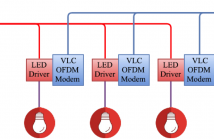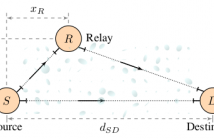- Read more about Effect of Noise Variance Estimation on Channel Quality Indicator in LTE Systems
- Log in to post comments
EffectNV.pdf
- Categories:
 11 Views
11 Views- Read more about Wideband Hybrid Precoder for Massive MIMO Systems
- Log in to post comments
This paper studies wideband hybrid precoder for downlink space-division multiple-access and orthogonal frequency-division multiple-access (SDMA-OFDMA) massive multi-input multi-output (MIMO) systems. We first derive an iterative algorithm to alternatingly optimize the phase-shifter based wideband analog precoder and low-dimensional digital
hybrid.pdf
- Categories:
 15 Views
15 ViewsRecent studies have demonstrated the effectiveness of proactive resource allocation under the assumption of perfect prediction of the user’s future data rate. In this paper, imperfect rate prediction merely based on the context information including large-scale channel gains of users and statistical information of system available resources is considered. Under the outagebased quality of service constraint, we propose a proactive power allocation policy aimed at minimizing the total transmit energy consumption.
context.pdf
- Categories:
 10 Views
10 Views
- Read more about Amplify-and-Forward Integration of Power Line and Visible Light Communications
- Log in to post comments
Abstract — This paper proposes a low-complexity scheme for the integration of power-line communication (PLC) and visible-light communication (VLC) systems. Rather than decoding the PLC signal prior to transmission from an LED luminary, a simple all-analog PLC/VLC amplify-and-forward (AF) module is described. The incoming PLC signals, which occupy a band of 2-28 MHz, are frequency down-shifted prior to transmission to increase the usable bandwidth of the LEDs. The required DC bias is then added to make the signals compatible with intensity modulation/direct detection (IM/DD).
- Categories:
 17 Views
17 Views
- Read more about Amplify-and-Forward Integration of Power Line and Visible Light Communications
- Log in to post comments
Abstract — This paper proposes a low-complexity scheme for the integration of power-line communication (PLC) and visible-light communication (VLC) systems. Rather than decoding the PLC signal prior to transmission from an LED luminary, a simple all-analog PLC/VLC amplify-and-forward (AF) module is described. The incoming PLC signals, which occupy a band of 2-28 MHz, are frequency down-shifted prior to transmission to increase the usable bandwidth of the LEDs. The required DC bias is then added to make the signals compatible with intensity modulation/direct detection (IM/DD).
- Categories:
 31 Views
31 Views- Read more about Generalized water filling problem
- Log in to post comments
Generalized water filling problem is implemented with the least number of flops (or lease computational complexity) possible.
- Categories:
 16 Views
16 Views- Read more about Experimental Demonstration of High-Order Modulation for Optical Camera Communication
- Log in to post comments
- Categories:
 4 Views
4 Views- Read more about Binary Rate Distortion With Side Information: The Asymmetric Correlation Channel Case
- Log in to post comments
Advancing over up-to-date information theoretic results that assume symmetric correlation models, in this work we consider the problem of lossy binary source coding with side information, where the correlation is expressed by a generic binary asymmetric channel. Specifically, we present an in-depth analysis of rate distortion with side information available to both the encoder and decoder (conventional predictive), as well as the Wyner-Ziv problem for this particular setup.
- Categories:
 7 Views
7 Views- Read more about New Results on the Sum of Two Generalized Gaussian Random Variables
- Log in to post comments
We propose in this paper a new method to compute the characteristic function (CF) of generalized Gaussian (GG) random variable in terms of the Fox H function. The CF of the sum of two independent GG random variables is then deduced. Based on this results, the probability density function (PDF) and the cumulative distribution function (CDF) of the sum distribution are obtained. These functions are expressed in terms of the bivariate Fox H function. Next, the statistics of the distribution of the sum, such as the moments, the cumulant, and the kurtosis, are analyzed and computed.
presentation.pdf
- Categories:
 27 Views
27 Views
- Read more about Rate-adaptive selective relaying using time diversity for relay-assisted FSO communications
- Log in to post comments
In this paper, a novel cooperative protocol for free-space optical (FSO) communication systems is proposed, wherein the performance analysis is evaluated over gamma-gamma (GG) fading channels with pointing errors. This novel relaying scheme is based on the optical path selection, source-destination (S-D) or source-relay-destination (S-R-D), with a greater value of fading gain or irradiance together with the use of repetition coding (RC), exploiting the potential time-diversity order available in the turbulent channel in order to maintain a high diversity order.
- Categories:
 20 Views
20 Views